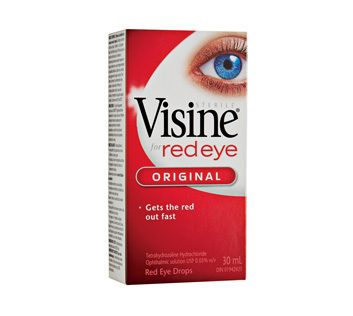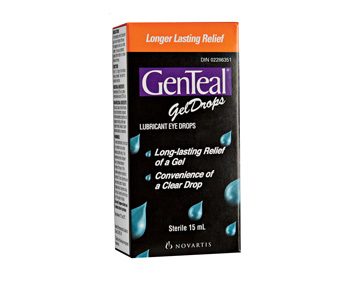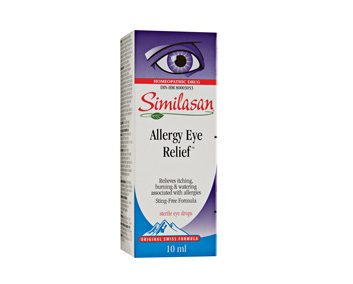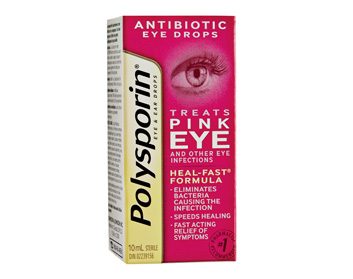
For redness caused by dryness
Examples: Clear Eyes Redness Relief; Refresh Redness Relief Redness Reliever and Lubricant Eye Drops; Visine Original for Red Eye
How they work: These drops are vasoconstrictors, which reduce redness by causing blood vessels to shrink, making eyes look whiter. Ingredients include naphazoline hydrochloride (Clear Eyes), phenylephrine hydrochloride (Refresh), or tetrahydrozoline hydrochloride (Visine).
Need to know: Redness is usually caused by dryness, says Dr. Greg Moloney, an ophthalmologist and clinical assistant professor in the department of visual sciences at the University of British Columbia. “These drops treat the symptoms, not the cause.” Prolonged use can decrease oxygen supply to the eyes and lead to even more redness, so they’re appropriate only for one-off occasions (such as before a job interview). You can safely apply one to two drops up to four times a day, but not for longer than 48 hours. Otherwise, it’s better to use lubricating eye drops. Never use vasoconstrictors while wearing contact lenses, and if you have glaucoma, check with your doctor before using them.

For dry eyes
Examples: GenTeal Gel Drops; Bausch & Lomb Duo-Lube Ointment; Hypotears Lubricant Eye Drops; Refresh Lacri-Lube Lubricant Eye Ointment; Systane Lubricant Eye Drops; Tears Naturale Forte Lubricant Eye Drops; Visine Enduring Moisture
How they work: These “artificial tears” mimic the viscosity, pH and lubricating effect of natural tears, says Alicia Chin, a pharmacist and pharmacy professional services advisor at Remedy’sRx in Markham, Ont. Common ingredients include petrolatum and mineral oil (Bausch & Lomb and Refresh), hypromellose (GenTeal and Tears Naturale Forte), Tamarindus indica seed polysaccharide (Visine), or combinations of polyethylene glycol with polyvinyl alcohol (Hypotears) or propylene glycol (Systane). Consider a gel or ointment format if you have very dry eyes, says Moloney. “They’re thicker, last longer and require less frequent application.”
Need to know: Use one to two drops per eye as needed. Gels and ointments can temporarily blur vision, so may be better suited for bedtime use. To minimize the chance of irritation, choose a preservative-free product such as Bausch & Lomb if you need drops more than four times daily. Unless ?the product is labelled “preservative-free,” always remove contacts before using. If your dry eyes have a quick onset and are associated with a dry mouth, see a doctor.

For dry eyes if you wear contact lenses
Examples: Boston Rewetting Drops; AQuify Long-Lasting Comfort Drops; Blink Contacts Lubricating Eye Drops; Clear Eyes Contact Lens Multi-Action Relief; Opti-Free Rewetting Drops; TheraTears Contact Lens Comfort Drops
How they work: Besides acting like artificial tears, these do not contain irritating or harmful ingredients that can be absorbed by or trapped behind lenses. “Most are sodium chloride-based,” says Chin.
Need to know: While you are wearing your lenses, insert one or two drops and then blink; repeat as needed. Some products, such as Boston Rewetting Drops, are not compatible with soft contact lenses, so read labels carefully before using. If you don’t get relief after two days, stop using the drops, remove your contacts and see a doctor.

For itchy eyes caused by allergies
Examples: Similasan Allergy Eye Relief; Alcon Naphcon-A Eye Drops; Cromolyn Eye Drops; Visine for Allergy Advance with Antihistamine
How they work: “Antihistamine eye drops counteract the histamines your body releases when you’re exposed to allergens, and which are responsible for symptoms such as itchiness and redness,” says Chin. Alcon and Visine contain the most common ingredient, pheniramine maleate. Another way to counteract histamine is to block its release with mast cell stabilizers, such as sodium cromoglycate (Cromolyn). Similasan is a homeopathic formula that contains extracts of apis and euphrasia; it stimulates the eye’s natural ability to fight allergy symptoms.
Need to know: It’s safe to use one or two drops up to four times daily. Never use these products while wearing contact lenses. If your condition persists for more than 72 hours without improvement, see a doctor. Some formulas, including the Visine and Alcon products in this section, contain vasoconstrictors, which reduce redness by causing blood vessels to shrink, so don’t use them for more than 48 hours.

For minor bacterial or viral conjunctivitis
Examples: Polysporin Antibiotic Eye Drops; Similasan Irritated Eye Relief
How they work: Polysporin contains the antibiotics polymyxin B and gramicidin, which can help clear a bacterial (but not viral) infection. Similasan is a homeopathic eye-drop formula with belladonna, euphrasia and hepar sulphuris; it is designed to stimulate the body to fight off the symptoms of pink eye caused by viruses.
Need to know: Since conjunctivitis can be difficult to diagnose, it’s always best to get a medical evaluation before you begin treating it. However, if symptoms are not severe and you suspect it is bacterial (because of a sudden redness and sticky discharge), it’s reasonable to try treating it with the Polysporin drops for the first 48 hours, says Moloney. Viral and allergic conjunctivitis won’t respond to antibiotic eye drops; instead, try Similasan to soothe symptoms. Polysporin may be used up to four times a day, one to two drops per application, while Similasan may be used for up to 72 hours, two to three drops per application as needed.
In either case, if you see no improvement after two days, if the condition gets worse or if there is pain, see a doctor. Don’t use the drops while wearing contact lenses, and toss opened bottles after 30 days. “Once opened, they will lose their effectiveness over time,” says Chin.
Related:
• Is laser eye surgery right for you?
• 6 foods for healthy eyes
• Can you get a sunburn on your eyes?
